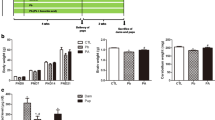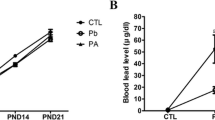Abstract
In the present study, we investigated the effects of ascorbic acid on lead-exposed developing cerebellum. Female rats were divided into the following three groups: control (distilled water), lead (0.2% lead acetate), and lead plus ascorbic acid (100 mg/kg/day, 10% solution). To evaluate the effect of lead exposure and ascorbic acid treatment accurately on the cerebellar development for the gestational period, we halted further treatment with lead and ascorbic acid in the dams after delivery of the pups. Although the ascorbic acid slightly decreased the lead level in pups, lead level was still high in the group treated with lead plus ascorbic acid group compared with the control group. The blood lead levels indicated that the ascorbic acid could facilitate both the excretion and transfer of lead from a dam to its pups via milk. At postnatal day 21, lead exposure significantly reduced the number of Purkinje cells in the cerebellar cortex of pups. Additionally, lead treatment induced degenerative changes such as reduction of glutamic acid decarboxylase (GAD67) and c-kit expressions are observed in the developing cerebellar cortex. In the cerebellum of the pups from the lead plus ascorbic acid group, reduction of the number of Purkinje cells, GAD67 expression, and c-kit immunopositivity were remarkably restored compared with the lead group. Our present results suggested that ascorbic acid treatment to lead-exposed dam exerted protective effects on the developing cerebellum against lead-induced neurotoxicity.




Similar content being viewed by others
References
Duruibe JO, Ogwuegbu MOC, Egwurugwu JN (2007) Heavy metal pollution and human biotoxic effects. International Journal of Physical Sciences 2:112–118
Silergeld EK (1990) Implications of new data on lead toxicity for managing and preventing exposure. Eviron Health Perspect 89:49–54
Hanna-Attisha M, LaChance J, Sadler RC, Champney Schnepp A (2016) Elevated blood lead levels in children associated with the Flint drinking water crisis: a spatial analysis of risk and public health response. Am J Public Health 106:283–290
D'souza HS, Dsouza SA, Menezes G, Venkatesh T (2011) Diagnosis, evaluation, and treatment of lead poisoning in general population. Indian J Clin Biochem 26:197–201
Vigeh M, Yokoyama K, Shinohara A, Afshinrokh M, Yunesian M (2010) Early pregnancy blood lead levels and the risk of premature rupture of the membranes. Reprod Toxicol 30:477–480
Vij AG, Satija NK, Flora SJ (1998) Lead induced disorders in hematopoietic and drug metabolizing enzyme system and their protection by ascorbic acid supplementation. Biomed Environ Sci 11:7–14
Liu B, Zhang H, Tan X, Yang D, Lv Z, Jiang H, Lu J, Baiyun R, Zhang Z (2017) GSPE reduces lead-induced oxidative stress by activating the Nrf2 pathway and suppressing miR153 and GSK-3β in rat kidney. Oncotarget
Mobarak YMS, Sharaf MM (2010) Lead acetate-induced histopathological changes in the gills and digestive system of silver sailfin molly (Poecilia latipinna). Int J Zool Res 7:1–18
Fahim MA, Tariq S, Adeghate E (2013) Vitamin E modifies the ultrastructure of testis and epididymis in mice exposed to lead intoxication. Ann Anat 195:272–277
Lidsky TI, Schneider JS (2003) Lead neurotoxicity in children: basic mechanisms and clinical correlates. Brain 126:5–19
Holtzman D, DeVries C, Nguyen H, Olson J, Bensch K (1984) Maturation of resistance to lead encephalopathy: cellular and subcellular mechanisms. Neurotoxicology 5:97–124
Goyer R (1990) Lead toxicity: from overt to subclinical to subtle health effects. Environ Health Perspect 86:177–181
World Health Organization (2010) Childhood lead poisoning. World Health Organization http://www.who.int/ceh/publications/childhoodpoisoning/en/
Bellinger D, Sloman J, Leviton A, Rabinowitz M, Needleman HL, Waternaux C (1991) Low-level lead exposure and children’s cognitive function in the preschool years. Pediatrics 87:219–227
Al-Shimali HM, Al-Musaileem AF, Rao MS, Khan KM (2016) Low-dose exposure to lead during pregnancy affects spatial learning, memory and neurogenesis in hippocampus of young rats. J Neurol Neurosci 7:3
Coon S, Stark A, Peterson E, Gloi A, Kortsha G, Pounds J, Chettle D, Gorell J (2006) Whole-body lifetime occupational lead exposure and risk of Parkinson’s disease. Environ Health Perspect 114:1872–1876
Wu J, Basha MR, Brock B, Cox DP, Cardozo-Pelaez F, McPherson CA, Harry J, Rice DC, Maloney B, Chen D, Lahiri DK, Zawia NH (2008) Alzheimer’s disease (AD)-like pathology in aged monkeys after infantile exposure to environmental metal lead (Pb): evidence for a developmental origin and environmental link for AD. J Neurosci 28:3–9
Han JM, Chang BJ, Li TZ, Choe NH, Quan FS, Jang BJ, Cho IH, Hong HN, Lee JH (2007) Protective effects of ascorbic acid against lead-induced apoptotic neurodegeneration in the developing rat hippocampus in vivo. Brain Res 1185:68–74
Chang BJ, Jang BJ, Son TG, Cho IH, Quan FS, Choe NH, Nahm SS, Lee JH (2012) Ascorbic acid ameliorates oxidative damage induced by maternal low-level lead exposure in the hippocampus of rat pups during gestation and lactation. Food Chem Toxicol 50:104–108
Hounkpatin ASY, Johnson RC, Guédénon P, Domingo E, Alimba CG, Boko M, Edorh PA (2012) Protective effects of vitamin C on haematological parameters in intoxicated wistar rats with cadmium, mercury and combined cadmium and mercury. Int Res J Biol Sci 1:76–81
Wilson JX (2002) The physiological role of dehydroascorbic acid. FEBS Lett 527:5–9
Chambial S, Dwivedi S, Shukla KK, John PJ, Sharma P (2013) Vitamin C in disease prevention and cure: an overview. Indian J Clin Biochem 28:314–328
Prasanthi RPJ, Reddy GH, Reddy GR (2006) Calcium or zinc supplementation reduces lead toxicity: assessment of behavioral dysfunction in young and adult mice. Nutr Res 26:537–545
Flora SJ, Tandon SK (1986) Preventive and therapeutic effects of thiamine, ascorbic acid and their combination in lead intoxication. Acta Pharmacol Toxicol (Copenh) 58:374–378
Buckner RL (2013) The cerebellum and cognitive function: 25 years of insight from anatomy and neuroimaging. Neuron 80:807–815
Altman J, Bayer SA (1985) Embryonic development of the rat cerebellum. III. Regional differences in the time of origin, migration, and settling of Purkinje cells. J Comp Neurol 231:42–65
Takayama C, Inoue Y (2004) Extrasynaptic localization of GABA in the developing mouse cerebellum. Neurosci Res 50:447–458
Silbergeld EK, Hruska RE, Miller LP, Eng N (1980) Effects of lead in vivo and in vitro on GABAergic neurochemistry. J Neurochem 34:1712–1718
Dieter MP, Matthews HB, Jeffcoat RA, Moseman RF (1993) Comparison of lead bioavailability in F344 rats fed lead acetate, lead oxide, lead sulfide, or lead ore concentrate from Skagway, Alaska. J Toxicol Environ Health 39:79–93
Goldstein BJ, Goss GM, Hatzistergos KE, Rangel EB, Seidler B, Saur D, Hare JM (2015) Adult c-Kit(+) progenitor cells are necessary for maintenance and regeneration of olfactory neurons. J Comp Neurol 523:15–31
Guijarro P, Wang Y, Ying Y, Yao Y, Jieyi X, Yuan X (2013) In vivo knockdown of cKit impairs neuronal migration and axonal extension in the cerebral cortex. Dev Neurobiol 73:871–887
Tamada H, Kiyama H (2016) Suppression of c-Kit signaling induces adult neurogenesis in the mouse intestine after myenteric plexus ablation with benzalkonium chloride. Sci Rep 6:32100
Manova K, Bachvarova RF, Huang EJ, Sanchez S, Pronovost SM, Velazquez E, McGuire B, Besmer P (1992) C-kit receptor and ligand expression in postnatal development of the mouse cerebellum suggests a function for c-kit in inhibitory interneurons. J Neurosci 12:4663–4676
Hossain S, Bhowmick S, Jahan S, Rozario L, Sarkar M, Islam S, Basunia MA, Rahman A, Choudhury BK, Shahjalal H (2016) Maternal lead exposure decreases the levels of brain development and cognition-related proteins with concomitant upsurges of oxidative stress, inflammatory response and apoptosis in the offspring rats. Neurotoxicology 56:150–158
Needleman HL, Schell A, Bellinger D, Leviton A, Allred EN (1990) The long-term effects of exposure to low doses of lead in childhood. An 11-year follow-up report. N Engl J Med 322:83–88
Millen KJ, Wurst W, Herrup K, Joyner AL (1994) Abnormal embryonic cerebellar development and patterning of postnatal foliation in two mouse Engrailed-2 mutants. Development 120:695–706
Sadeghi A, Ebrahimzadeh Bideskan A, Alipour F, Fazel A, Haghir H (2013) The effect of ascorbic acid and garlic administration on lead-induced neural damage in rat offspring’s hippocampus. Iran J Basic Med Sci 16:157–164
Naresh R, Dwivedi SK, Swarup D, Patra RC (2003) Effect of ascorbic acid on milk lead and cadmium level on subclinical cases of mastitis. Environ Contam Toxicol 71:899–904
Simon JA, Hudes ES (1999) Relationship of ascorbic acid to blood lead levels. JAMA 281:2289–2293
McClain RM, Becker BA (1975) Teratogenicity, fetal toxicity, and placental transfer of lead nitrate in rats. Toxicol Appl Pharmacol 31:72–82
Mousa AM, Al-Fadhli AS, Rao MS, Kilarkaje N (2015) Gestational lead exposure induces developmental abnormalities and up-regulates apoptosis of fetal cerebellar cells in rats. Drug Chem Toxicol 38:73–83
Sausbier M, Hu H, Arntz C, Feil S, Kamm S, Adelsberger H, Sausbier U, Sailer CA, Feil R, Hofmann F, Korth M, Shipston MJ, Knaus HG, Wolfer DP, Pedroarena CM, Storm JF, Ruth P (2004) Cerebellar ataxia and Purkinje cell dysfunction caused by Ca2+-activated K+ channel deficiency. Proc Natl Acad Sci U S A 101:9474–9478
Hosseini-Sharifabad M, Sabahi A (2014) Stereological estimation of granule cell number and Purkinje cell volume in the cerebellum of noise-exposed young rat. Iran J Med Sci 39:387–390
Mani J, Chaudhary N, Kanjalkar M, Shah PU (1998) Cerebellar ataxia due to lead encephalopathy in an adult. J Neurol Neurosurg Psychiatry 65:797
Brochin R, Leone S, Phillips D, Shepard N, Zisa D, Angerio A (2008) The cellular effect of lead poisoning and its clinical picture. GU Journal of Healh Science 5:2
Bernocchi G, Bottone MG, Piccolini VM, Dal Bo V, Santin G, De Pascali SA, Migoni D, Fanizzi FP (2011) Developing central nervous system and vulnerability to platinum compounds. Chemother Res Pract 2011:315418
Takeda H, Yoshiki A, Nishikawa SI, Nishikawa S, Kunisada T, Sakakura T, Amanuma H, Kusakabe M (1992) Expression of c-kit, a proto-oncogene of the murine W locus, in cerebella of normal and neurological mutant mice: immunohistochemical and in situ hybridization analysis. Differentiation 51:121–127
Kim D, Im JO, Won YJ, Yoon SY, Lee EJ, Lee JH, Hong HN (2003) Upregulation of c-Kit receptor and stem cell factor in cerebellar inhibitory synapses in response to kainic acid. J Neurosci Res 71:72–78
Hertz L (2013) The glutamate-glutamine (GABA) cycle: importance of late postnatal development and potential reciprocal interactions between biosynthesis and degradation. Front Endocrinol (Lausanne) 4:59
Yeganeh-Doost P, Gruber O, Falkai P, Schmitt A (2011) The role of the cerebellum in schizophrenia: from cognition to molecular pathways. Clinics (Sao Paulo) 66:71–77
Lasley SM, Gilbert ME (2002) Rat hippocampal glutamate and GABA release exhibit biphasic effects as a function of chronic lead exposure level. Toxicol Sci 66:139–147
Yusa T (2001) Increased extracellular ascorbate release reflects glutamate re-uptake during the early stage of reperfusion after forebrain ischemia in rats. Brain Res 897:104–113
Acknowledgements
This research was supported by the faculty research fund of Konkuk University in 2009.
Author information
Authors and Affiliations
Contributions
SMN, SCA, THG, JSS, and JHL conceived and conducted the experiments, and collected the data. SMN and JHL analyzed the data and wrote the manuscript. SSN and BJC participated in designing and discussing the study. All authors approved the final version of the manuscript.
Corresponding author
Ethics declarations
Conflict of Interest
The authors declare that they have no conflict of interest.
Rights and permissions
About this article
Cite this article
Nam, S.M., Ahn, S.C., Go, TH. et al. Ascorbic Acid Ameliorates Gestational Lead Exposure-Induced Developmental Alteration in GAD67 and c-Kit Expression in the Rat Cerebellar Cortex. Biol Trace Elem Res 182, 278–286 (2018). https://doi.org/10.1007/s12011-017-1086-z
Received:
Accepted:
Published:
Issue Date:
DOI: https://doi.org/10.1007/s12011-017-1086-z




